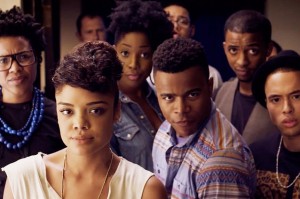The Hunger Games: Mockingjay
Posted on November 20, 2014 at 5:59 pm
B+| Lowest Recommended Age: | Middle School |
| MPAA Rating: | Rated PG-13 for intense sequences of violence and action, some disturbing images and thematic material |
| Profanity: | Mild language |
| Alcohol/ Drugs: | None |
| Violence/ Scariness: | Intense peril and violence with hundreds of deaths, grisly scenes, torture |
| Diversity Issues: | None |
| Date Released to Theaters: | November 21, 2014 |
| Date Released to DVD: | March 6, 2015 |
| Amazon.com ASIN: | B00PYLT0OW |

It seems no different at first. While the second in the “Hunger Games” series ended with the surprise last-minute rescue of heroine Katniss Everden (Jennifer Lawrence), and the even bigger surprise that insider Plutarch Heavensbee (Philip Seymour Hoffman) was secretly helping to organize a rebellion against the fascist dictator President Snow (Donald Sutherland), we begin this first half of the final installment with Katniss gripped by anxiety and terror, listening to the voice of someone we cannot see, calling her “Miss Everdeen,” which sounds respectful, even deferential, but still delivering orders. Is this more of the same? Just another version of the world of Panem where the thinnest gloss of rhetoric about ideals and values is used to disguise the vilest abuse, corruption and even genocide.
No, this is District 13, thought to have been exterminated, but in reality literally driven underground, as much as 40 stories down, as they work to find a way to overthrow President Snow’s totalitarian regime. They are led by Alma Coin (a somber Julianne Moore), President of the rebel forces. Coin can be abrupt, but it is a manifestation of urgency and decisiveness, not dictatorship. Snow dresses in spotless white, surrounded by lush white roses, and the capital city of Panem is a riot of garish, decadent colors. District 13 is all in gray, looking a bit like Janet Jackson’s “Revolution” video, evoking its uniformity in dedication to its goal and seriousness of purpose. Coin is not cynical, but she is realistic, constantly establishing priorities, understanding the consequences but willing to pay the price.
Coin and Heavensbee believe Katniss is what they have been waiting for, a symbol who will communicate to the other districts that the time has come for rebellion. She is the Mockingjay, named for the distinctive birds creation through genetic manipulation mating with natural species. Katniss is a figure whose sacrifice and resilience lend her enormous national credibility. She was made into a celebrity by Snow through the original Hunger Games.
Now Coin wants to use that as a weapon against Snow’s regime. They try to make a “propo” (propaganda) video with CGI effects, but realize that Katniss is too honest to be effective unless she is telling the truth. So, they take her to see what has happened to her home community in District 12. It has been reduced to rubble, with an enormous pile of skeletons of those who died there. And so Katniss is able to produce the outrage and resolve Coin’s forces are looking for in the video.
Katniss agrees to serve as symbol, on condition that the rebel forces rescue the Hunger Games competitors who were left behind, and pardon them for whatever they have done. She believes Peeta (Josh Hutcherson) is dead, but then he appears on a televised broadcast hosted by Caesar Flickerman (Stanley Tucci), the game show emcee with the sepulchral smile. Her joy turns to horror as she hears him plead for her to stop any opposition to Snow. Has he been tortured? Does he know something she does not?
That seems more likely as the initial attempts at rebellion result in enormous losses, including the firebombing of a hospital. With support from Haymitch (Woody Harrelson), now reluctantly sober, and Effie (Elizabeth Banks), whose adjustment to live without wigs, make-up, and fashions that would make Lady Gaga say “too much” provides much of the film’s comic relief, Katniss struggles with PTSD and with the painful moral dilemmas of asking others to risk their lives for a cause that may be doomed.
The series is a respectful adaptation of the books, but its real strength is not the writing of Suzanne Collins but the performance of Jennifer Lawrence, who is to the film all that Katniss is to the rebellion and more. Once again, Katniss is the heart of the story and Jennifer Lawrence is the heart of the film. In a plot that has her devastated and horrified much of the time, she manages to give a performance that is moving but never an atom out of control. Her conviction and presence is what anchors the film and makes the wildest absurdities of the storyline work. While I am not in favor of splitting the book in two just to double the box office, this version skillfully finds a story arc that comes to a satisfying conclusion while making us eager to see what happens next.
Translation: Brutal dictatorship relying on military force, bombing (including bombing unarmed civilians), shooting, executions, hundreds injured and killed, disturbing images including wounded civilians and piles of skeletons, torture (off screen), some teen kisses
Family discussion: What made Katniss the best choice to symbolize the rebellion? Why was it necessary to have a symbol? Why did President Snow refuse to use the word “rebel?”
If you like this, try: the first two “Hunger Games” films and “The Maze Runner”




